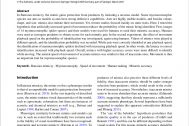Obsah
In Batesian mimicry, the mimic gains protection from predators by imitating a noxious model. Some myrmecomorphic species use ants as models as ants have strong defensive capabilities. Ants are highly mobile models, and besides colour, shape, and size, mimics also imitate their movement. Yet, former studies focused mainly on static traits. Here, I tested the hypothesis that artificially increased speed of movement reduces the probability of the mimic being identified. First, images of 14 myrmecomorphic spider species and their models were used for humans to rank their mimetic accuracy. Humans were used as surrogate predators to obtain scores for each mimetic pair. In the second experiment, the effect of movement playback speed on the probability of identification was investigated, again using humans. Videos of mimics were played at different speeds, and the identification probability was recorded. While ants were correctly identified at any playback speed, the identification of myrmecomorphic spiders declined with increasing playback speed. In other words, the latency to correct identification increased with playback speed. Overall, mimics with higher accuracy scores were more difficult to identify while moving. The natural speed of movement of accurate mimics was similar to that of inaccurate ones. Movement is thus an important trait for myrmecomorphic species.



